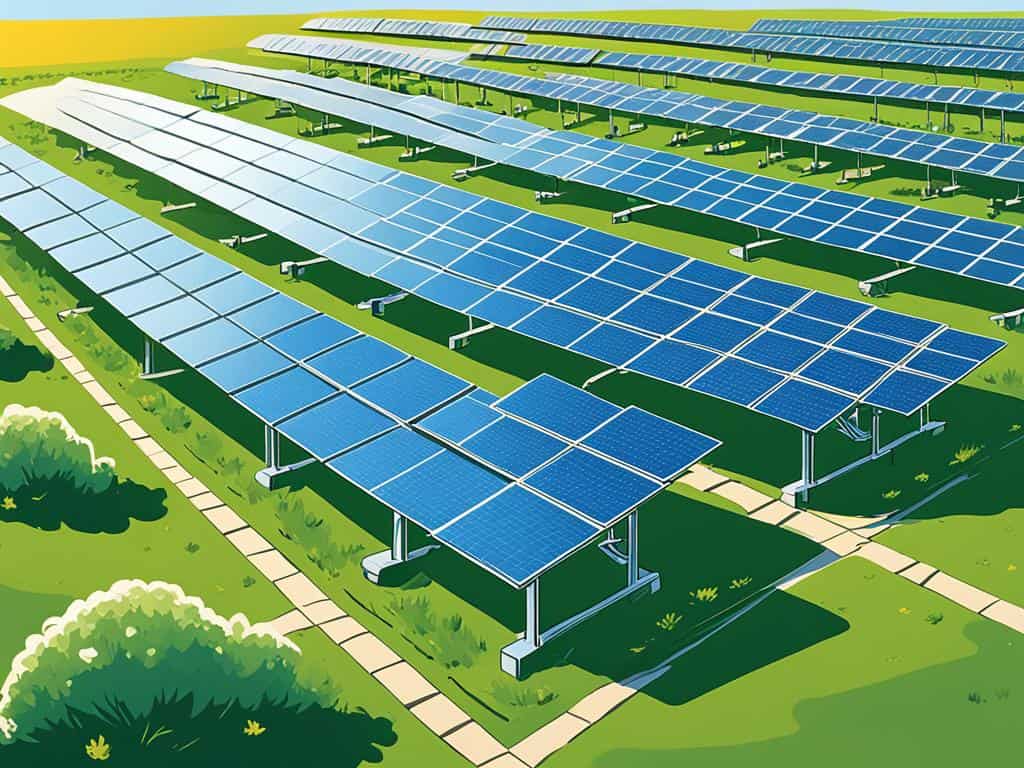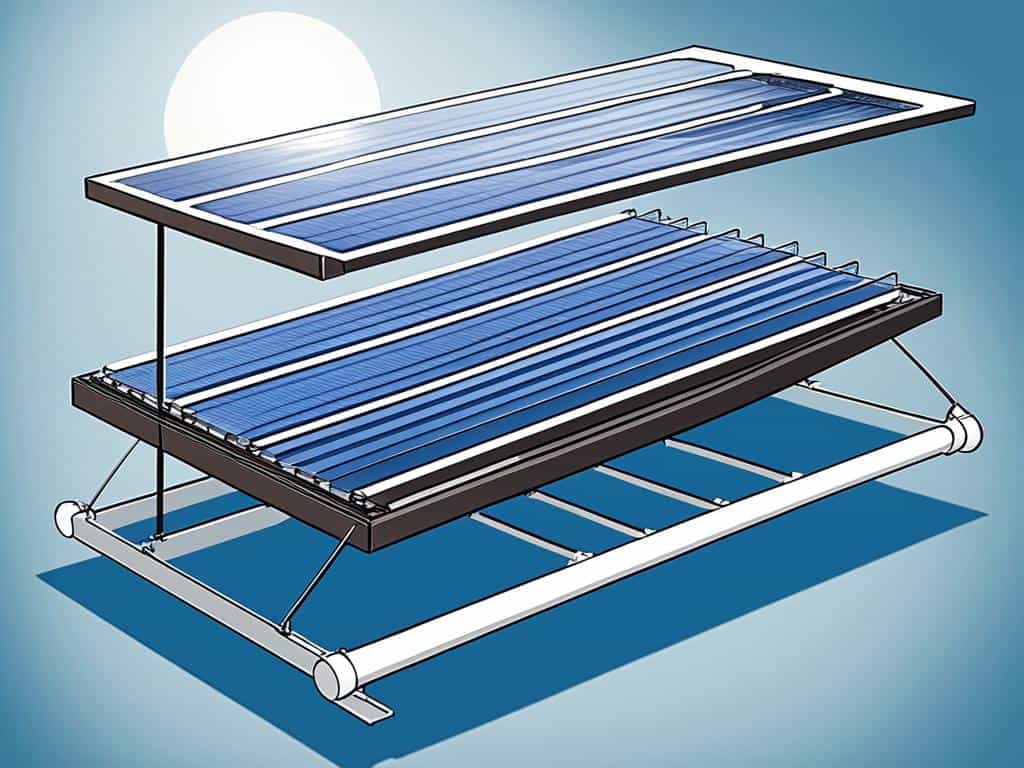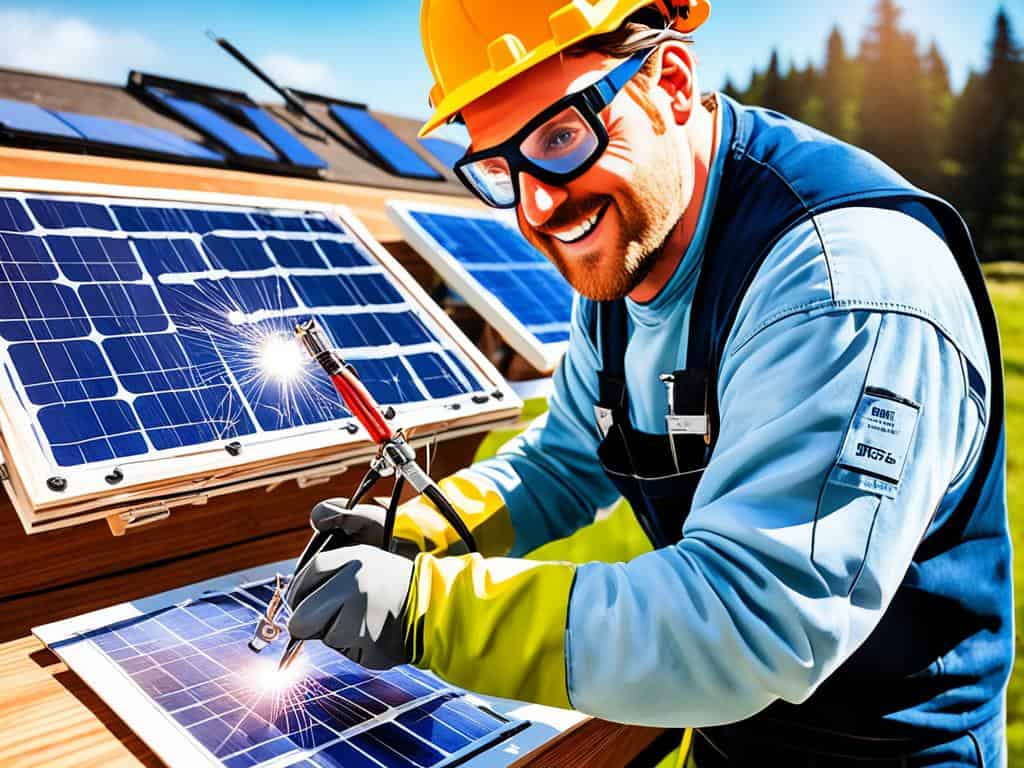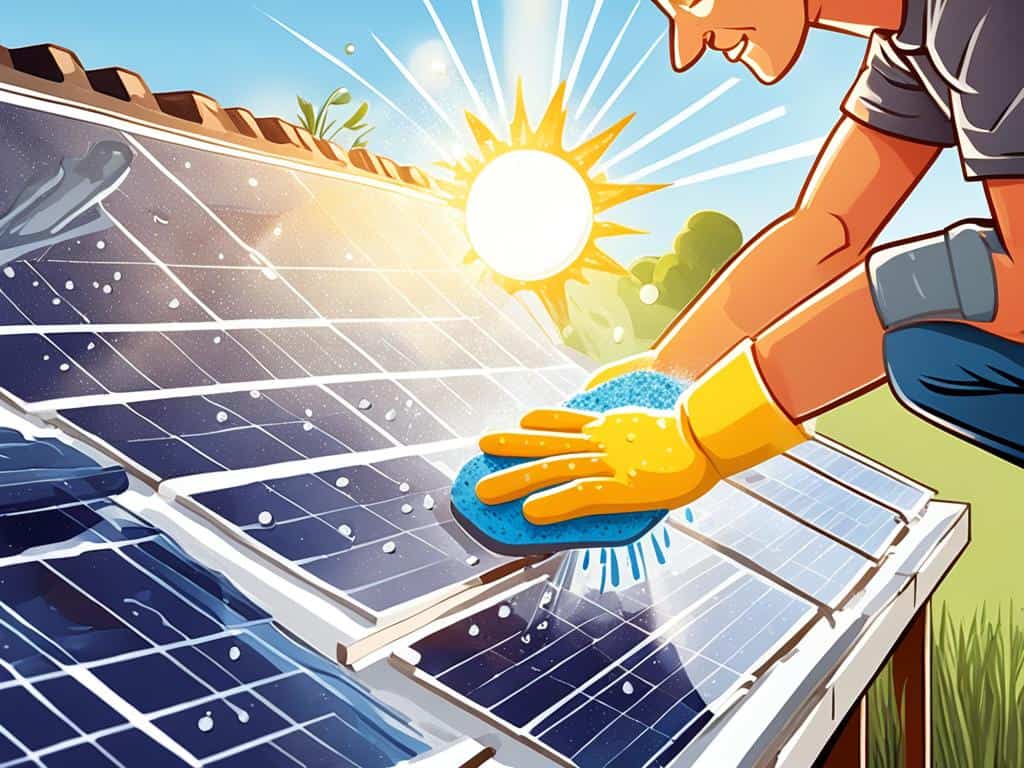Flat Plate and Concentrating Collectors Explained
Explore the essentials of solar energy with our guide on flat plate and concentrating collectors, key to efficient renewable power in India.

India aims to be a leading name in the renewable energy world. It showcases its innovations in solar thermal tech using solar collectors. Flat plate and concentrating collectors play a big part in solar energy collection. Flat plate collectors, seen on many rooftops, heat up to just under 100°C. They catch both direct and scattered sunlight. This makes them efficient and low-maintenance, fitting the renewable energy mission well.
Key Takeaways
- Flat plate collectors are key in making India’s solar energy collection more user-friendly.
- These collectors’ ability to use both types of solar radiation makes them very adaptable.
- India uses durable materials, like copper and aluminum, in these collectors for sustainable energy.
- Adjusting things like tilt angle and spacing can improve solar collector efficiency.
- Cleaning cover plates regularly is critical to keep flat plate collectors working well.
- Knowing the technical sides of these collectors, like stagnation temperature, helps in optimizing their use.
Introduction to Solar Energy Collection
The demand for clean and renewable energy has made solar energy very popular, especially in India. Solar thermal technologies are at the heart of this movement. They use the sun’s energy to create heat and electricity. Solar collectors are key. They come in many designs and help turn sunlight into energy for homes, businesses, and industries.
The Role of Solar Collectors in Renewable Energy Systems
Solar collectors do more than just gather sunlight. They are critical for making photovoltaic panels work efficiently and are a big part of the solar power system. They help heat water and space in a green way, reducing our carbon footprint. When we put many collectors together, they can even power big solar thermal power plants, creating a lot of electricity.
Understanding the Basics of Flat Plate and Concentrating Collectors
There are two main types of solar collectors: flat plate and concentrating. Flat plate collectors are simple. They have metal boxes with a clear cover, an absorber plate, and insulation. This design easily captures and keeps solar heat.
On the other hand, concentrating collectors use mirrors to focus the sunlight. This creates higher temperatures needed for big power plants or to power engines. These collectors can do many things, like heating homes or cooling industries.
| Type of Collector | Primary Uses | Efficiency Characteristics | Common Material | Lifespan |
|---|---|---|---|---|
| Flat Plate Collectors | Residential Water Heating, Space Heating | Passive heating, requires no tracking | Copper, Aluminum | 25+ years |
| Evacuated Tube Collectors | Water Heating, SHIC, SAC | Reduces heat loss, high vacuum | Glass-glass evacuated tubes, Barium flash getter pump | Varies |
| Line Focus Collectors | Steam Generation for Power Plants | Uses parabolic troughs or dishes, solar tracking needed | Reflective materials | Varies |
| Concentrated Photovoltaics | Electricity Generation | Utilizes high-efficiency photovoltaic cells and point focus collectors | Specialized photovoltaic materials | Varies |
All solar collectors must be tough. They face many weather challenges. From needing strength for harsh conditions to advanced designs for tracking the sun, these technologies show the innovation in solar power and renewable energy.
The Mechanics of Flat Plate Solar Collectors
Exploring solar thermal technologies leads us to a standout piece: the flat plate solar collector (FPC). Known for its reliability and efficiency, it’s key in capturing solar energy. We’ll look into how these devices are designed and made to gather thermal energy efficiently.
Design and Structure of Flat Plate Collectors
The heart of a flat plate collector is its absorbent copper plate. Copper is chosen for its excellent ability to conduct heat. This plate catches the sun’s rays, a process crucial for heating. Its design allows for effective sunlight absorption, making it a trusted choice for consistent heating in various uses. A common size in India is 4 x 8 ft, balancing efficiency and weight at over 200 pounds.
FPCs feature designs with plates in parallel or series setups. This choice allows for either more fluid flow or better heat spread. Understanding these allows you to pick the right arrangement for your needs, like home water heating or industrial applications.

Materials and Construction: Enhancing Thermal Efficiency
Building flat plate solar collectors combines precise engineering and material science. They consist of absorbing plates, fluid tubes, insulation to reduce heat loss, sometimes a glazed cover, and a sturdy casing. It’s their combined workings, often housed in strong aluminum, that make them effective energy solutions.
These collectors can significantly increase water temperature. A square foot of collector can heat two gallons of water by over 60°C daily. For larger systems, this means heating up to 300 litres of water. This shows the impressive capability of these systems.
The true strength of an FPC is its design that captures energy from all directions while minimizing heat loss. This makes them versatile and crucial in India’s solar energy scene. They are vital for a future with clean, renewable energy.
Working Principle of Concentrating Solar Collectors
Concentrating solar collectors lead the revolution in solar energy. They’re highly efficient in turning sunlight into thermal energy or electricity. Through mirrors and lenses, they precisely focus sunlight, boosting the efficiency of solar panels.
These systems mainly use parabolic troughs, dishes, and power towers. They focus sunlight onto receivers or absorber tubes. This process heats a fluid inside to generate steam. The steam then powers turbines, creating electricity in solar thermal plants.
In places needing a lot of hot water, like hospitals, concentrating solar collectors shine. They make heating more cost-efficient and have a long life. With evacuated tube collectors, they last up to 25 years, losing very little heat.
But they’re not only for heating. They’re also key for high photovoltaic panel performance. Point focus collectors, for example, need sun tracking to work best. They’re great for powering Stirling engines or concentrated photovoltaic systems. Their versatility and efficiency make them invaluable in solar technology.
- Vacuum tube collectors offer greater efficiency for thermal applications.
- Parabolic troughs and dishes concentrate solar energy for high-temperature heat generation.
- Power towers focus an immense amount of solar energy on a central receiver.
- Advanced tracking is required to maintain optimal alignment with the sun.
| Type of Collector | Common Use | Efficiency | Expected Lifespan |
|---|---|---|---|
| Flat-plate solar collectors | Space heating, water heating | Varies by type (25%-45%) | Long (Exact years vary) |
| Vacuum tube collectors | High-temperature industrial processes | Greater due to reduced heat loss | ~25 years |
| Line focus collectors | Solar thermal power plants | High efficiency in arrays | Designed for long-term use |
| Point focus collectors | Concentrated photovoltaics, Stirling engines | Dependent on active solar tracking | Varies, high durability |
The search for efficient solar energy methods keeps advancing. Concentrating solar collectors make a big difference in the market. They go beyond homes and offices, reaching into industrial solar thermal energy systems.
Flat Plate and Concentrating Collectors: Comparative Analysis
Choosing between flat plate and concentrating collectors is key for sustainable energy solutions. Both types are vital in solar power but differ in efficiency and cost. This depends on their use and the size of the project.
Flat plate collectors work well at temperatures between 160-205 degrees Fahrenheit. This makes them a good fit for solar cooling systems. Concentrating collectors, however, can reach even higher temperatures. This makes them better for big projects needing more heat.
For projects up to 6 tons, flat plate collectors are more budget-friendly. They give more energy for the money spent. But for bigger energy needs, concentrating collectors are more efficient. They give a better return on investment in large systems.
The success of solar collectors depends on how much useful energy they can get. This is linked to their efficiency, the sun’s position, the amount of sunlight, and the collector’s design. Understanding these factors helps make the best choice between the two.
The selection also relies on the system’s components, like controls and maintenance. Arkla Industries recommends specific performance standards for solar collectors used with the Solaire chiller. This highlights the need for the collector to work well with the system’s other parts.
| Collector Type | Optimal Temperature Range (°F) | Btu/invested dollar (for up to 6 tons) | Btu/invested dollar (for larger loads) |
|---|---|---|---|
| Flat Plate Collectors | 160-205 | Higher | Lower |
| Concentrating Collectors | 160 and above | Lower | Higher |
Choosing the right collector for solar power generation means looking at both performance and future needs. Flat plate collectors are great for smaller, cooler operations. Concentrating collectors do better in large, hotter conditions. This guide is key for achieving the best in sustainable energy.
Types of Flat Plate Collectors
India is using the sun’s energy for a green future. The key player in this change is solar thermal technology, focusing on flat plate collectors. These collectors are popular for turning sunlight into heat for buildings and come in many designs for different needs.
Glazed vs. Unglazed Flat Plate Collectors
There are two main types of flat plate collectors: glazed and unglazed. Glazed flat plate collectors have a clear cover that keeps in heat. They are perfect for heating water in homes, making them an eco-friendly option for thermal efficiency.
Unglazed flat plate collectors don’t have this cover, fitting lower heating needs better. They work well in places that don’t need high temperatures, like for heating pools. They combine environmental care with practical energy use effectively.
Orientation and Configuration Variants
Flat plate collectors can also vary by orientation and how they’re set up. These changes affect how much fluid they hold and how they distribute heat. You can have them in landscape or portrait orientation, with plates connected in series or parallel. This flexibility ensures they work well anywhere, from Europe to other parts of the world.
Glazed flat plate collectors last over 25 years, showing they’re a lasting solution for green energy. Their performance and durability meet the ISO 9806 standard. This means they could be more attractive compared to evacuated tube collectors, especially when looking at direct efficiency.
Components and Materials in Concentrating Collectors
Renewable energy systems are always evolving, and concentrating solar collectors are key. They use special parts to capture the sun’s energy. These parts include mirrors or lenses, a receiver for the solar energy, and a system to follow the sun.
For these collectors to work well, they need high-quality materials. Mirrors are usually made of polished aluminium or glass coated with silver. Receivers can handle high heat and are made from strong metals. These materials help the collectors work efficiently, playing a big part in solar power.
Keeping these collectors running smoothly is vital for a greener future. In India, there’s a big push to make these systems work better. This helps India use more clean energy. Here’s a table that shows what these systems are made of:
| Component | Function | Common Materials Used |
|---|---|---|
| Reflective Surface | To concentrate sunlight onto a focused area | Polished aluminium, Silver-coated glass |
| Receiver/Absorber | To collect and convert solar energy into heat | Stainless steel, High-temperature resistant alloys |
| Tracking System | To follow the sun’s movement throughout the day | Electronic controllers, Actuators |
In India, the push for solar energy is strong. Concentrating solar collectors are at the heart of this. They are made with great care and advanced design. These efforts align with India’s clean energy goals. The focus on new ideas keeps making solar energy better.
Sizing and Scaling for Optimal Energy Collection
It is crucial to size and scale solar energy systems correctly. This ensures they are both practical and efficient. Factors such as the size of flat plate collectors and the efficiency of concentrating collectors play a big role. Since solar energy helps cut CO2 emissions and reduces reliance on fossil fuels, getting the size right is very important.
Calculating Energy Needs and Collector Sizing
Choosing the right solar collector size means looking at energy needs closely. Flat-plate collectors are about 50% to 60% efficient, while evacuated tube collectors can reach 80% to 90%. Water heaters powered by solar energy are up to 70% efficient. This is key for meeting the demand for water heating, which uses a lot of household energy.
| Collector Type | Mean Energy Efficiency | Ideal Applications |
|---|---|---|
| Flat-Plate | 50% to 60% | Residential water heating, Space heating |
| Evacuated Tube | 80% to 90% | High-temperature industrial processes, Cold regions |
| Solar Water Heaters | Up to 70% | Household water heating, Small-scale hot water needs |
Efficiency isn’t the only metric for sizing solar systems. Evacuated tube collectors, for example, average 43% annual solar fraction. Understanding solar fraction helps tailor sizing to specific energy needs and locations. This enables efficient collector sizing for peak demand reduction and CO2 emissions. Such sizing supports the use of PV and thermal storage technologies.
Adapting Collector Designs to Accommodate Diverse Roof Setups
Design flexibility is key for fitting solar systems to various roofs. For flat plate collectors, roof size and direction matter for maximizing energy collection. This is especially true in cities, where roof space can be limited. Concentrating collectors, used in higher temperature settings, require careful planning for installation.
Choosing the right solar tracking system depends on location and solar patterns. Advanced designs help make the most of every roof’s layout. These designs improve the efficiency of collectors on challenging roofs.
In the end, smart sizing and scaling of solar collectors are fundamental. They help tap into solar thermal tech’s full potential. By doing so, we can meet our growing need for sustainable, renewable energy.
Advancements in Solar Thermal Technologies
Renewable energy is changing fast, all thanks to new solar thermal tech. A big step forward is connecting sun tracking systems with solar collectors. This match-up aims to follow the sun’s path, which improves energy capture and makes solar power systems more efficient.
![]()
There’s also exciting progress in materials science, giving flat plate collectors better materials. These materials enhance how well they hold heat. This isn’t just a win for technology; it’s key for greener and more sustainable energy solutions.
| Technology Feature | Impact on Efficiency | Contribution to Renewable Energy |
|---|---|---|
| Sun Tracking for Concentrating Collectors | Optimizes sun exposure, increasing thermal energy output | Amplifies the potential of solar thermal power plants |
| Advanced Material for Flat Plate Collectors | Enhances heat retention, reducing energy loss | Supports higher efficiency in domestic and commercial heating applications |
As the sun travels across the sky, sun tracking tech makes sure solar collectors catch as much sunlight as possible. This boosts the power of renewable energy, moving us towards a future where our power comes completely from renewable sources. The dream of endless, clean energy is closer, with the sun leading the charge.
Innovative Features of Flat Plate Collectors
In India, there’s a big move towards using solar energy better. Flat plate collectors are a big part of this push. They’re getting better because of new features. These improvements make the collectors more efficient. They also help keep the environment clean. One exciting feature is sun tracking technology. It lets the collectors get the most sunlight possible. This makes the collectors more adaptable and easier to use. It shows how important these collectors are for using solar energy better.
Integration of Sun Tracking Technology
Flat plate collectors are now using sun tracking technology. This tech adjusts the collectors to follow the sun all day. It makes sure the collectors work really well. This is a big step towards using solar energy better and in a cleaner way.
Eco-friendly Solutions for Sustainable Energy Systems
Eco-friendly technology is key for these solar collectors. They’re very important for homes and businesses wanting clean energy. By using these collectors, India is working towards a greener future. It’s all about using renewable energy sources better.
| Feature | Impact on Flat Plate Collectors | Number of Studies |
|---|---|---|
| Folded Sheet Metal Usage | Enhances structural integrity and durability | 1 |
| Aluminium Absorbers | Improves thermal conductivity for process heat | 1 |
| Nanofluids & Strip Inserts | Boosts heat transfer efficiency | 1 |
| Impact of Glass Covers | Limits heat loss, increasing thermal performance | 1 |
| Stainless Steel Coatings | Provides high absorption and corrosion resistance | 3 |
| Thermal Performance Enhancement | Advances heat retention and transfer in solar air collectors | 2 |
| Baffle Arrangements | Improves airflow and heat exchange rates | 2 |
The progress in flat plate collectors reflects wider efforts in solar energy. These advancements involve various collectors, fluids, and conditions. It shows how the field of sustainable energy is growing. India’s push for better solar energy use highlights its goal for a future powered by clean energy.
Benefits of Concentrating Collectors in Solar Power Generation
The field of solar power is now focused on concentrating collectors. These systems are known for providing high heat, which is key for solar plants. They use the sun’s rays to create more heat than flat collectors. This is not only a big achievement but also helps make solar power more common.
Concentrating collectors use less material but have a big impact. In America, they show how mature and promising this technology is. For example, the Solar Energy Generating System in the Mojave Desert. It worked from 1984 to 2023 and included nine plants with power up to 88 MW. This shows the technology can grow.
Places like the Solana Station in Arizona and Mojave Solar in California prove these systems can last and provide a lot of power, with 296 MW and 275 MW, respectively. Both started in the early 2010s. And the Ivanpah Facility, with a massive 393 MW across three fields, shows what concentrating collectors can do.
Even though there are challenges like needing systems to track the sun, the benefits are clear. The Crescent Dunes in Nevada, for instance, reaches 110 MW. And even if some projects, like the CLFR in Bakersfield, didn’t work out, they help improve the technology.
To sum up, the U.S. is pursuing many solar projects, but the lack of big solar dish projects shows there’s room for new ideas. The future of solar is bright, with concentrating collectors at the forefront of creating sustainable energy.
Conclusion
India is making great strides in using solar thermal technologies. They mainly use flat plate and concentrating collectors. These green energy sources could greatly change India’s energy use. The flat plate collectors (FPC) work well and are flexible. They can heat a large amount of water every day efficiently. A square foot of collector plate can heat about 10 liters of water above 60°C. This shows the big effect they can have.
Flat plate collectors are easy to maintain and last a long time. They give more energy for each dollar spent, especially for needs not over 6 tons. They absorb over 95 percent of solar radiation because of their black surface coatings. This lets them save energy even when it’s not very warm. FPCs work in different weather, from single to triple-glazed collectors. This shows big progress in making renewable energy fit various weather needs.
India is committed to growing its use of renewable energy. This commitment will help improve solar thermal technology. They choose designs based on sun exposure and efficiency. And they pick materials that help manage heat well. The right placement of collectors and absorber plates is key. It helps capture more heat and transfer it better. India is at the start of a solar energy revolution. It’s building a future that’s kind to the environment, with smart innovation and efficiency.


